Complete Streets
We explain the process for putting the Complete Streets Policy into action.
Key elements of complete streets
Prioritizes pedestrians and public transit
Complete Streets established a modal priority framework. This modal framework informs transportation related decision making.
It prioritizes people as they
- Walk or roll
- Bike, take transit, or other micromobility services
These ways to get around take priority over driving.
Informs all transportation related decisions
- All City transportation related decisions will follow Complete Streets. Implementation will include all elements within the public right of way.
- All transportation projects are subject to the process laid forth by the policy.
- We use a Complete Streets checklist to document that projects follow the process. The checklist is specific to the project.
When we apply Complete Streets
Complete streets applies to all public and private
- Projects
- Programs
- Initiatives
When they interact with and impact the public right of way.
2021 update
The City adopted the original policy in 2016.
The updates include:
- Updated references to modal needs that have arisen in the last five years. For example, scooters and new types of delivery services.
- Includes policy guidance for micromobility (such as scooters).
- Updated language to be consistent with the Transportation Action Plan.
- We updated it in the areas of construction impacts and winter maintenance.
- See the Transportation Action Plan
- Added a definition of the Complete Streets process.
- Removed the exemptions process.
New additions to the policy
Transportation Action Plan
Minneapolis is creating more travel options for more people by the year 2030.
Request accessible format
If you need help with this information, please email 311, or call 311 or 612-673-3000.
Please tell us what format you need. It will help us if you say what assistive technology you use.
Contact us
Public Works
Phone
Address
City Hall350 Fifth St. S.Room 203
Minneapolis, MN 55415
Office hours
Monday - Friday
8:00 a.m. - 4:30 p.m.






